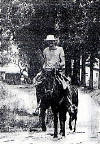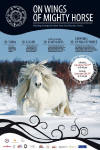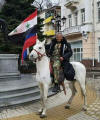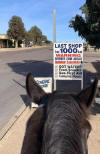|
1250 Pages of
Equestrian Wisdom now available
When the Guild Website was created in 2001, its goal was to demonstrate that
you and your horse can undertake a life-changing equestrian journey of your
own. That is why this massive website has always been a commercial-free,
open source of information designed for global distribution. It is a gift to
the world from the equestrian Argonauts who are Members of The Long Riders'
Guild. With the publication of this News update the Guild website has become
the largest repository of equestrian travel knowledge in history!
2019
marked the twenty-fifth anniversary since the formation of the
Long Riders’ Guild
in 1994.
READ MORE…
|
 |
|
Virus crisis affects Long Riders world wide
Equestrian travel is one of the victims of the current global epidemic.
International border crossings were closed and even internal horse travel
was banned. As a result Long Riders have found themselves under house
arrest, deported back to their country of origin, or marooned overseas with
their horses. This photo shows the stewardess on an Air Uzbek plane that
returned two equestrian travelers to France after their ride across Central
Asia was cancelled. However previous plagues such as the Antonine Plague of
165, the Justinian Plague in 541, the Bubonic Plague in 1347 and the Third
Plague in 1855 failed to stifle humanity’s wanderlust. Long Riders are
resilient, patient and determined to swing into the saddle. So though the
first part of 2020 has rendered life unrecognizable, history proves that
there is a bright dawn coming.
|
 |
|
Robin’s
Recovery
After 49 days in hospital, during which time he was given a 5% chance of
survival, Robin Hanbury-Tenison overcame the Covid 19 virus which had nearly
killed him. Part of Robin’s near-miraculous recovery was due to the healing
effects of a “secret garden” that had been built on the hospital grounds. To
demonstrate his faith in the power of Nature to help heal, Robin decided to
raise funds to build another hospital garden. To do so, Robin vowed he would
climb Cornwall’s highest peak. The only problem was that Robin was so weak
when he left hospital, he couldn’t walk. This article tells the story of a
man who wouldn’t be defeated, the woman whose love helped him recover, and
their battle to overcome the toughest challenge in their long adventurous
life together.
READ MORE
|

Robin Hanbury-Tenison raises the flag on the summit of Cornwall’s highest
peak.
Photo
courtesy of Cat Vinton @catvinton |
|
Robin’s Rescue
Robin and Louella Hanbury-Tenison are among the original
Founding Members
of the Long Riders’ Guild. On March 16th
2020 Robin became critically ill due to the coronavirus. He was rushed
from the family home in Cornwall, to a hospital in Plymouth, where he was in
a coma for a month, was put on a ventilator and, because his kidneys began to
fail, had to be put on a dialysis machine. Robin’s condition became so grave
that he “spent seven weeks flickering between life and death.” In emails
sent to the Guild and family friends, Louella provided a moving account that
explains how a team of dedicated doctors and nurses battled to save her
husband’s life and thereby brought about a medical miracle.
READ MORE...
|
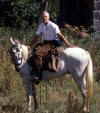 |
|
Indian
Travels on Horse to cope with virus
Meghalaya, meaning "abode of clouds," is a state in northeastern India. With
an average annual rainfall as high as 470 inches, it is the wettest place on
earth. The spread of the Covid 19 virus has added to the troubles of local
people. But Westar Tongwah decided the answer to present problems was to
revive a traditional mode of transportation. Tongwah, who learned to ride as
a child, used to travel extensively from one place to another on his horse;
but eventually he stopped riding and adapted to modern transport. The onset
of the Covid virus caused him to reassess the reliability and cost of
equestrian transport. “Due to a shortage of vehicles in my village and due
to huge transportation costs, I decided to use my Koh-mut (Horse) for
travelling to far off places,” he said. “In these hard times, I prefer to
ride my horse since I need only grass to feed him, not like cars that cost
petrol and other charges.” |
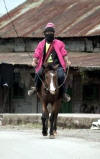 |
|
Romanian Rides Despite Virus Restrictions
A Romanian man traveled 40 kilometres by horse to attend the birth of his
son after public transport was halted in the north-eastern city of Iasi
because of the COVID-19 pandemic. Sergiu Ion Ciobotariu caught the attention
of the police as he rode through the city on horseback. To escape a possible
15-year jail term for breaching travel restrictions, he produced a
self-certified form explaining that his journey was essential because his
wife had gone into labor. Police accepted his justification but nevertheless
gave him a warning for riding a horse within city limits. Ciobotariu
explained that there was no other way to reach his wife and newborn baby in
the quarantined city as all public transport had come to a halt during
lockdown. "I wanted to take the tram but couldn't because of coronavirus
restrictions. Then I wanted to go by bike but they wouldn't allow me to
cross the bridge to get to the city, so then I took my horse," he said.
|
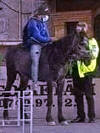 |
|
Running Like
Wildfire – The Equine Virus that Devastated America
This isn’t the first time a deadly virus has threatened the existence of the
United States. Imagine an equestrian health disaster that crippled all of
America, halted the government in Washington DC, stopped the ships in New
York, burned Boston to the ground and forced the cavalry to fight the
Apaches on foot. It was an equine tragedy so deadly that one wave of the
infection swept south like a Biblical plague from its origin in Toronto,
Canada, down the Atlantic Seaboard to Havana, Cuba, leaving everything in
its path in ruins in weeks, while another branch simultaneously raced west
to the Pacific. A special
LRGAF Study
documents how within 90 days the equine health disaster of 1872 affected
everything Americans took for granted, everything that ensured their safety,
every city, town and village where they lived and left everything in its
path under siege.
By 1870 there were an estimated 600,000 horses in New York State alone.
Yet when the Epizootic incapacitated 99% of them, men had to harness
themselves to wagons instead.
|
 |
|
Thoughts on
being a Long Rider
Some children aspire to be doctors, solicitors or politicians when they
become adults. Not Cathleen Leonard! Growing up in England, Cathleen harboured a secret dream to explore the planet on horseback. But her desire
became rooted in reality when she discovered the Long Riders’ Guild website.
“Everything changed when I discovered the Long Riders’ Guild. I was about
14-years-old and was trawling some obscure corner of the internet, looking
for evidence that horseback travel was still possible in the 21st century,
when I stumbled across the Guild’s website. It was like opening a door to
another world! Here were the people who were living my dreams, travelling
the world on horseback, proving that it could still be done. I spent years
gathering information and reading about their adventures.
If it weren't for reading so many of the articles
on the Guild in my youth, and being given a tantalising taste of the
freedoms of the open road, I can say without the shadow of a doubt that I
would never have set off on any of my journeys, and my life would certainly
not be what it is today.” An extensive
interview reveals details of Cathleen’s journeys, explains how she became a
leading equestrian author, and provides valuable advice for anyone aspiring
to swing into the saddle and follow her example.
READ MORE… |
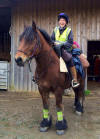 |
|
Long Rider
Artist Tours USA
American Long Rider
Katie Cooper
is following in the hoof prints of other travelling equestrian artists who
painted as their explored the world.
READ MORE… |
 |
|
Embrace the Change
Because of her many contributions and achievements, in 2019 Lucy Leaf was
designated a
Living Treasure
by the Long Riders’ Guild. In a special message to younger Long Riders, Lucy
wrote, “We
can get lost in dismay, or we can embrace the change.” The American Long
Rider’s message is mirrored by Her Majesty, Queen Elizabeth, who said
"Together we are tackling this disease, and I want to reassure you that if
we remain united and resolute, then we will overcome it.
READ MORE…
|
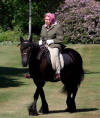 |
|
 |
Mouhamad-Ajmal Abdoulvahab
and Angela Milli, along with their children Ingis and Iyan, rode
across Argentina. |
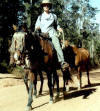 |
Anna Beck
rode from Perth to Esperance, Australia. |
|
 |
Karen Considine
rode across Spain, on a route pioneered in 1961 by Historical Long Rider
Penelope Chetwode. |
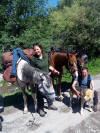 |
Elise and Léopoldine Desprez
rode from Tash-Rabat in southern Kyrgyzstan to Tapalovka in eastern
Kazakhstan. |
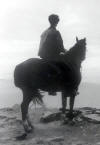 |
Richard Eastwood
completed journeys in Wales and across the American Southwest. |
|
 |
Sam Faulkner
rode across Argentina. |
 |
Stef
Gebbie
rode solo across the Australian continent, starting
at
the mouth of the Snowy River on the east coast of Victoria and finished at
the Margaret River on the west coast of Western Australia. |
|
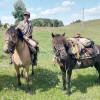 |
Paola Giacomini
completed a solo journey
through Mongolia, Russia, Lithuania, Poland, Czech Republic, Austria and
Italy. |
|
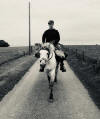 |
|
Louis Hall
rode across Scotland and England, via John O’Groats to Land’s End. |
|
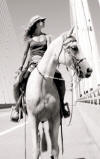 |
Linny Kenney
rode ocean to ocean across the United States, from California to New
Hampshire. |
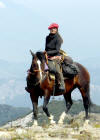 |
Solveig Schmidt
made numerous journeys through the Andes Mountains in Argentina. |
 |
Petra Uhlmann
rode from the Baltic Sea to the Bavarian Alps. |
|
 |
The Guild welcomes Wagon Master
Angela Wood, who
completed a 4,500 mile journey through twelve American states. |
|
Journey
Across the Americas Concludes
An eight-year ride that crossed North, Central and South America has been
successfully completed. In 2012 Filipe Leite rode 10,000 miles from
Canada to Brazil.
In 2017 Filipe rode from Brazil to Tierra del Fuego. The third portion of
the journey began in Fairbanks, Alaska and concluded in July at Calgary,
Canada, where Filipe had begun his journey eight years before. Though he had
crossed all the nations from the Arctic Circle to the End of the World,
Filipe remarked, “There is no competition. The horse unites us all.” |
 |
|
Long Rider
Crosses Germany
Despite the global lockdown,
Sabine Keller
was able to complete a journey across her nation. Between 2014 and 2017
Sabine made three journeys through Germany, France, Luxemburg, Netherlands
and Belgium. Each of those rides was more than one thousand miles.
Accompanying Sabine once again were her two trusty Mangalarga Marchador
mares, Isis, who has travelled 17,000 kilometres (10,000 miles) and her
younger sister, Marenga, who has travelled 13,000 kilometres (8,000 miles). |
 |
|
Living
Treasure Carries Guild flag across Brazil
Pedro Luis de Aguiar
(right),
who at 87 is
the oldest Long Rider in the saddle, has departed on a journey that will see
him and his companion carry the Guild flag across their country to the
Atlantic Ocean.
READ MORE…
|
 |
|
Journey Across All of Argentina
Marcos Villamil has departed on a historic ride that will take him into
every province in his native Argentina. Prior to his departure, Marcos was
mentored by Long Riders Benjamin Reynal, Agustin Mayer, Stevie Anna Plummer
and Filipe Leite, all of whom contributed valuable information about their
own journeys in that nation. In a message to the Guild Benjamin wrote, “As
you see, the local branch of the Guild is strong and dynamic. Almost none of
these relations could have existed without the LRG. I find that to be a very
rich part of this worldwide organization.”
|
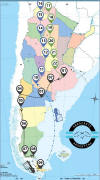 |
|
From Central
Asia to the Scottish Highlands
Pete Breidahl and Luisa Mayr began the journey of a lifetime when they
swung into the saddle in August, 2019 and began a trans-continental
equestrian journey. They have ridden in Mongolia, Uzbekistan, Kazakhstan and
Georgia. Because of government restrictions they have ridden different
horses as they continue to journey westward. Despite visa problems, giant
wolves, and the lurking menace of the Covid virus, the duo has pressed on.
They are currently in Turkey and hope to enter Europe via Bulgaria early
next year.
|
 |
|
70 Year
Anniversary of Ana Beker’s Journey from Argentina to Canada
A special article recalls the remarkable
25,000 kilometer ride that crossed Argentina, Bolivia, Peru, Ecuador,
Colombia, Panama, Costa Rica, Nicaragua, Honduras, Guatemala, Mexico, the
United States and Canada.
READ MORE… |
 |
|
Canadian Long Rider makes Solo Gallop across Gobi Desert
Julie Veloo
is the founder of the world’s longest annual charity endurance ride. Despite
the global lockdown the determined Long Rider completed a 700 kilometre solo
journey across Mongolia so as to raise funds to feed, care for and educate
hundreds of the most seriously disadvantaged Mongolian children, and provide
training, employment and opportunities for in excess of 110 community
members and displaced herdsmen.
READ MORE… |
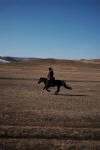 |
|
Long Rider becomes Long Walker on Spiritual Pilgrimage
New Zealand Long Rider
Ian Robinson
had already made solo journeys across Mongolia, Tibet, Afghanistan and
Siberia. When the global pandemic halted any further equestrian travel, Ian
decided to make the most of the situation and embark on the
Shikoku Pilgrimage. The route, which is one of the few circular shaped
pilgrimages in the world, led Ian to
88 Buddhist Temples. Starting in early October, Ian walked 1300
kilometres in eight weeks. Prior to his departure, Ian wrote to the Guild to
express his thoughts on the benefits of making such a journey. “My ride
across Tibet, which was supposed to be a spiritual journey, taught me one
thing; pilgrimages don't bring you enlightenment! But for me that was a
valuable lesson to learn. The way to tell if your spiritual development is
happening is to check your thoughts. If they are becoming happier and more
positive then it is working!” |
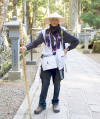 |
|
From Russia’s Pacific to England’s Atlantic -
Nikita Gretsi is preparing to make the
first “ocean to ocean” equestrian journey across Siberia, Russia and Europe.
READ MORE…..
|
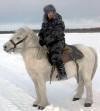 |
|
A Profound Contribution to Horses and Humanity
- Volume 1, is just the
first of the three volumes subtitled A Study of the Geographic and
Spiritual Equestrian Journey, based upon the Philosophy of Harmonious
Horsemanship. At 563 pages, small print, its size and scope matches the
breadth of its title. As might be expected, this is not for the casual
reader. It is massive in size because there is simply nothing like it out
there, anytime, anywhere.
READ MORE…
Captivating, High Adventure on the Trail- All True - Volume 2, the
lengthiest of the set, is pure adventure related to travel on horseback. It
describes the challenges Long Riders have faced around the globe. This is
where horse and rider meet five-foot long electric eels, attack condors, the
stalking lion or a pack of screaming hyenas. This is where you think you’ve
heard it all, and the next page brings yet another hair-raising story. And
- it’s all true. READ MORE…
Final Volume is the Journey- the Change – Volume 3, this is the
wind-down from the high adventure and challenges of Volume 2. It is the
thought-provoking part of the journey, the part that feeds the soul. It is
not merely a “how-to” volume. The author would say it is, more importantly,
a “why to” book. Once again, you fall under the spell of a master
story-teller who is also an investigative journalist. The stories and
information he has unearthed are astounding.
READ MORE…
|

|
|
Follow Your
Dreams
"The things I
could say about this book! The Horse Travel Handbook itself is a journey,
from the excitement of planning, dangers of travel, rejoice in overcoming
challenges, and overall acknowledgement of mortality. The book doesn't just
inform those that wish to practice the ancient art of equestrian travel on
the dangers and joys of travel. It has provided myself, and as I can assume
others, with motivation to see their plans through. In a fast paced world
this book shows that Long Riders, world and century wide, still plan to slow
down to find themselves and their trusty mount. Thanks to this book, my
journey has already begun".
Jon
Vickers is preparing to undertake an ‘ocean to ocean’ equestrian journey
across the USA. |
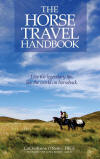 |
|
A
glimpse into a lost and forgotten world
Khyber
Knights
is beautifully written and tells a tale so gripping that you will not be
able to put the book down. It is filled with information that reveals the
lost world where this marvelous story took place. The book is not just
gripping but truly inspiring. It is filled with adventure, courage, bravery,
romance, history and culture. Nothing short of astonishing and inspiring, I
found myself itching to read the next page and as I was getting closer to
the end I could feel a sense of sadness. Having read this book it inspired
me to find my own adventures and if they come close to the story told in
Khyber Knights, I know I will have succeeded.
Nikita Gretsi
is preparing to ride from Russia’s Pacific to England’s Atlantic |
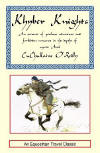 |
|
An Equestrian
Travel Classic
Many Long Riders aspire to be authors. Few succeed. And only a handful have
written a book that has endured for more than 50 years and influenced three
generations to follow in the author’s hoof prints! Filled with the
adventures which
Verne Albright
survived during his historic ride from Peru to California, the new fourth
edition is a gripping read that is richly illustrated.
READ MORE…
|
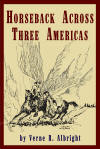 |
|
A Beautiful Book recalls a Historic Journey
On May 25, 1991, three men departed from São Paulo on an ambitious mission.
They were determined to ride the length and breadth of Brazil. Their route
would take them down to the southern tip of the country, then up to the
northern edge and finally back to where they began the ride. For 775 days
the author,
Pedro Luis de Aguiar,
his brother,
Jorge Dias de Aguiar
, and their friend
José Reis, rode their
Manga Larga Marchador stallions through every type of challenge Brazil could
throw at them. Based on Pedro’s diaries,
Marcha Brazil 14 Mil
contains a treasure trove of stunning colour photographs, brightly coloured
illustrations of Brazil’s fauna and flora, and engaging maps depicting the
route. The result is the most visually beautiful Long Rider book ever
created. |
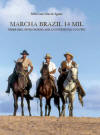 |
|
Long Ride to
the End of the World
After riding 16,000 kilometers from Canada through ten countries to his home
in Brazil, the Long Rider,
Filipe Masetti Leite’s
life fell apart. So, what does he do? Saddle up and ride on, of course. In
this second volume in his Journey America trilogy, Filipe shares his
fifteen-month adventure riding six horses from Barretos, Brazil, across
three more countries, through windswept deserts, frozen mountains, and a
scorched Patagonian landscape to Tierra del Fuego, the Land of Fire. |
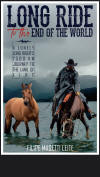 |
|
Riding in the
Hoof Prints of History
In 1961 the intrepid Penelope Chetwode borrowed a mare and set off on an
adventure into the remote backlands of Spain. Her subsequent book Two
Middle-Aged Ladies in Andalusia was given to Karen Considine for her
15th Birthday. For 52 years Karen held onto the dream of retracing
Penelope’s hoof prints. In 2019 Karen rallied her courage, saddled her
horse, swung into the saddle and set off in search of her Long Rider
heroine.
Penelope’s Route
is an account of Karen’s journey across the same trails, mountains, plains
and villages some sixty years later. In essence it’s an account of adventure
on horseback; but it also examines the historical evolution of Spain’s rural
communities. On her travels Karen met some of the same people as Penelope,
who remembered the British lady’s unique character and unusual expedition,
but had no idea Penelope had immortalised them in writing. |
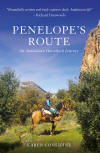 |
|
Marco Polo
would have endorsed this book
And the Venetian would have understood what motivated
Karla (Edmunds) Christenson
to set off in 1973 on an equestrian journey into the unknown. Marco was
seventeen years old when he departed from his home in Venice in 1271. Karla
wasn’t much older when she swung into the saddle 702 years later. Though
separated by centuries, the Italian and American Long Riders had much in
common. Though inspired to explore the world on horseback, sceptical
stay-at-homes warned Marco and Karla that they would be slain by murderous
Mongols or American criminals. They weren’t. Karla’s book explains how a
young woman from Maine followed the compass in her heart and rode towards
the distant horizon of Montana.
|
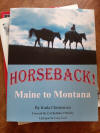 |
|
An Uplifting
Book in a time of Anxiety
Back in 1982, before cell phones and GPS, 23-year-old
Missy Priblo
rode ocean to ocean across the United States. Her mounted journey from New
York to California made her a curiosity to people and the press. Now 38
years later Melissa “Missy” Priblo Chapman has written a memoir of her
2,000-mile ride telling of the months on the road and the people she
encountered along the way.
|
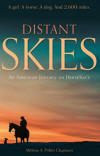 |
|
Rare Words of
Wisdom
At the first international meeting of Long Riders,
DC Vision,
who had ridden 14,000 miles across the United States, famously said, “They
either get it in the first ten miles or they never get it at all.” The “IT”
DC was referring to was the deep spiritual awakening which a handful of Long
Riders achieve during their journey. It has nothing to do with mileage, as
proved by the clueless braggarts who are obsessed with proving their
validity by the number of miles rolling over on the odometer placed in the
pommel of their saddle horns. It has nothing to do with enduring the
dangers, delays and hardships that have always made equestrian travel
extremely hazardous. No, what DC was referring to was the phenomenon
described in the
Encyclopaedia of Equestrian Exploration
as “the long quiet,” that rare state of emotional grace which has been
described as the Holy Grail of equestrian travel. In search of neither
praise nor profit,
Lisa Stewart’s
beautifully written book recounts how her horse, Chief, took the Long Rider
across a country and deep into her own soul.
|
 |
|
Time marches
on but the challenges remain the same
It was November, 2013 when
Jesse McNeil rode his horse, Pepper, up to the shore of the Atlantic Ocean.
The duo had started at the Pacific Ocean in Oregon and then travelled for
eight months through 14 states. Written with honesty, grit, and grace,
On the Hoof
captures an arduous voyage that broke a man down and built him back up, with
the help of one special horse.
|
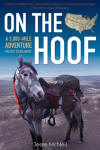 |
Fiddler on the Hoof is an engaging book written by one of the finest new
equestrian travel authors. In the summer of 2018 fiddle player and Long
Rider
Cathleen Leonard
embarked on her second equestrian journey. This time Cathleen was
accompanied by Romanian Long Rider
Vlad Coman.
They set off from Cornwall, travelled through the South West of England and
across South Wales, then crossed the sea to Ireland where they rode the
length of that country. Cathleen’s book details the realities of horseback
travel in a hectic modern world no longer sympathetic to this historic mode
of transport. Relying on the help of hospitable strangers, this
heart-warming tale provides an honest and reassuring account of the better
side of human nature, highlights the beautiful bonds developed over hundreds
of miles between horses and humans, and is interwoven with the music,
folklore, myths, and history of Ireland. Cathleen and Vlad are now in
Portugal with all their equines preparing to begin another long journey when
travel restrictions are lifted. This time they will be riding
3,000 miles across nine European countries to Romania.
|
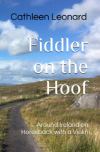 |
|
An Overdue and Accurate Guide
Author Bill Tate has done the public a special service by compiling a badly-needed guidebook for one of Great Britain’s most popular places to travel on
horseback. Though many bridleways shown on the map may appear appealing, the
reality can be a steep rocky gully, a treacherous bog or a locked gate. The
author spent years researching and recording the bridleways in this
beautiful part of the UK. The result is a handy sized reference guide that
will fit into a saddlebag and provide confidence to riders who wish to
explore the famous dales and moors of Yorkshire. |
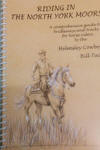 |
|
The Enchanting Tale of a Duke and a Dog that changed
Lithuania’s History
Written by
Gintaras Kaltenis,
the country’s most renowned Long Rider author, this charming book tells the
tale of
the Duke Alšis and the extraordinary dog who helped reignite a nation‘s
equestrian heritage.
Once Lithuania’s independence from the Soviet Union had been assured, the
country’s riders began to revive their ancient equestrian culture. Not only
were traditions rejuvenated, a series of remarkable journeys were taken on
the country’s famous Žemaitukai horses. In 2011 a team of Lithuanians
decided to launch the country’s
Riding Renaissance
by making a 2,000 kilometre equestrian journey from the Baltic to the Black
Sea. The ride was dedicated to the memory of Lithuania’s national hero,
King Vytautas the Great.
Accompanying them was Alšis, the lovable but
homeless canine vagabond whose endearing journey took him from Belarus to
the Lithuanian Prime Minister‘s chair.
This book is an extraordinary adventure about the true-life values of
friendship, devotion, perseverance and possibly even reincarnation. |
 |
|
Have Donkey, Will Travel
Some things never change! When Eve Brackenbury announced in 1923 that she
planned to travel across Scotland and England in the company of her donkey,
Hotep, sceptics howled that the young woman would be murdered or die on the
moors. But as Eve’s granddaughter, author Gill Brackenbury, describes, the
“post-WWI Bohemian” overcame every challenge with courage and curiosity. The
book describes how the intrepid Eve and the protective Hotep endured
atrocious weather, crossed the dangerous moors and fended off unnerving
attention when a group of men suddenly put Eve at risk. |
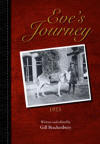 |
|
Long Rider Charity Champion Passes Away
The Guild regrets to report the death of Jakki Cunningham, who founded the
renowned
Caravan of Hope,
which travelled with Camargue horses from France to England.
Like many Long Riders who rode before her,
Jakki Cunningham
swung into the saddle to champion a noble cause. She was the Founder of the
Sète-Lorient-London, a unique equestrian charity which used
two horse drawn wagons as support vehicles, while Jakki led a team of
young people who were
mounted on Camargue horses. At the end of a journey from the south of France
to London, which involved countless overnight stops, the horses were donated
to Riding for the Disabled centres. One example of the organisations helped
by SLL is the Wormwood Scrubs Pony Centre in West London, run by Sister Mary
Joy Langdon. Jakki’s slogan,
“Horses and people unite for the cause of children with disabilities” became
famous on both sides of the English Channel. Three of her young companions,
Luke Tucker,
Bethany Jameson
and
Chris Bradbury,
became Members of the Guild. An illustrated biography recounts
Jakki’s remarkable career as an equestrian ambassador. Wise, generous and
friendly, one friend described Jakki as,
“An amazing lady, who had a dream and made it happen. Jakki adored the
horses, enriched the lives of many young people and was an inspiration to
all.”
|
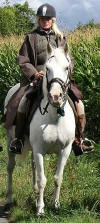 |
|
Adventures in Afghanistan -
The Long Riders' Guild is sorry to report the death of Sean Jones (right).
The Guild website was created so as to connect the
world's equestrian travellers with the traditions of their past. It also
preserves the fragile “Stories
from the Road”
that Long Riders often risk their lives to ride and retrieve. The
publication of two such remarkable stories marked a special moment in modern
equestrian travel history. In 1973
Sean Jones,
Kevin Rigby
and
Raffaele Favero
rode across Afghanistan. That remarkable adventure was recounted in Sean’s
article
The Company of Horses.
What occurred next was unprecedented. The three Long Riders set off to ride
from Afghanistan, over the Khyber Hills into Pakistan’s Tribal areas. Their
plans went astray when they were
Captured by Afghan Bandits.
The Guild welcomed Sean as a Member in 2018 and honoured the memory of Kevin
and Raffaele in the
Historic Long Riders Collection. |
 |
|
Death of
Heroic Long Rider Horse
In 2012
Filipe Leite
set off to ride from Calgary, Canada to his family’s ranch at Espírito Santo
do Pinhal, Brazil. Accompanying him were three faithful friends, Frenchy,
Bruiser and Dude. This photo shows the team when they reached Bolivia in
2014. After the completion of the difficult journey, the horses were retired
to a pasture at the Leite family ranch. Sadly Dude (right), who was bitten
by a vampire bat infected with rabies, died in 2017. The Guild is sad to
report that Bruiser (centre), the rock-steady leader of the team, was slain
by colic in late 2020. |
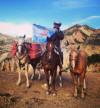 |














